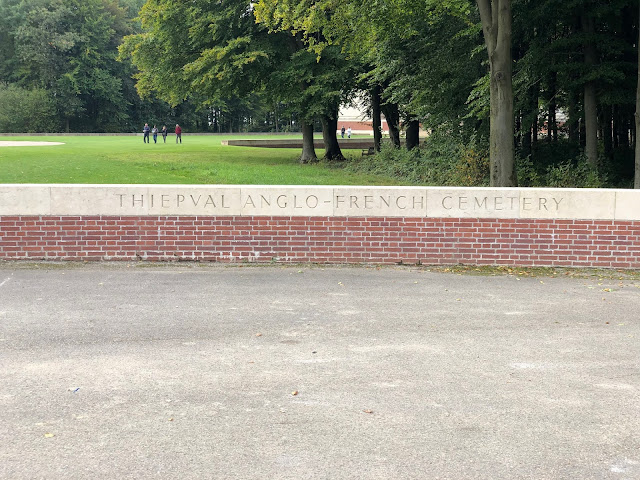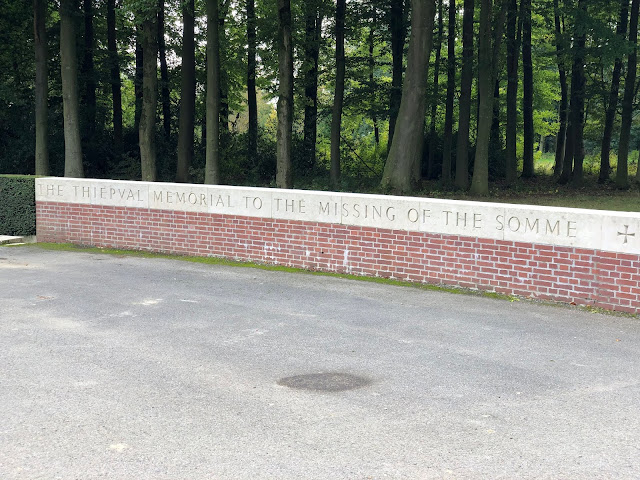We checked out of the Mercure Hotel, Arras this morning and started the Battle of the Somme portion of the tour. This battle was originally to be a combined British/French attack. Unfortunately, someone did not tell the Germans because they began their assault on Verdun which siphoned off much of the French forces, leaving the Battle of the Somme to be primarily a British campaign.
The assault began on July 1, 1916 and lasted until November 18, 1916 when the British decided they had had enough. During that time, over one million soldiers perished. The British lost roughly 400,000, the French lost 200,000 and the Germans lost 400,000. There were over 70,000 missing in action. The area of the Battle of the Somme is literally a mass grave, full of undetonated ordinance and unaccounted for victims.
The first day of the battle, July 1, 1916, is known as the worst day in British military history when they suffered nearly 60,000 casualties with almost 20,000 fatalities.
We started the day by visiting a small cemetery full of Indian and Chinese laborers.
Next we visited the "Sunken Road". This was a sunken road in "no man's land" between the British and German front lines. The British Lancashire Fusiliers had infiltrated to this point in preparation for the "big push", the name given to the Battle of the Somme. This stretch of road was immortalized in the 1916 British documentary and propaganda war film, shot by two official cinematographers, Geoffrey Malins and John McDowell (Battle of the Somme).
 |
| The Sunken Road from the 1916 documentary (32 minutes, 13 seconds) |
 |
| Hawthorn Mine Ridge |
The initial thrust was a total disaster with most of the British being massacred.
We visited the memorial of the Newfoundlander's. They were in the second wave and suffered almost 90% casualties as a regiment of thye 29th Division.
The first wave at Beaumont Hamel was annihilated. The Newfoundlander's were then called upon to
"assist" the first wave. They got less than one half way across the open terrain and were completely destroyed.
 |
| Dead Tree, half way across no man's land. As far as the Newfoundlander's got |
 |
| The missing Newfoundlander's |
 |
| Memorial to the 51st Highlanders who ultimately took the position in 1918 |
 |
| Lots of Black Watch |
 |
| Still not safe to mow in many parts, so the sheep are used to maintain the grass. |
The Devonshire Cemetery was a particularly sad place to visit. This British regiment were in their trenches at this very spot when the went "over the top". They were machine gunned and fell back into their own trenches, over 150 soldiers died. The few survivors ended up just filling in the trenches which became the grave for their comrades.
There are cemeteries everywhere. Some with just a few dozen graves, some with thousands. The British and French practice was to put the cemeteries at the places where the soldiers died. So if you see a cemetery, that was the location of some sort of battle or engagement.
We also visited the Australian memorial.
And the site of the first use of tanks in WWI.
The last place we stopped at was the Butte de Warlencourt, aka, the pimple. This battle ground has little military importance, but someone thought it did and the British spent nearly 100,000 lives to try to take control of it. This is also where the last act of the Battle of the Somme took place on November 18, 1916. The British simply just called off the battle.
 |
| The pimple |
We then made our way into Amiens and checked into our hotel, the Mercure Amiens. Literally across the street is the Notre Dame Cathedral of Amiens. Purportedly the largest cathedral in France. They had closed the building before we arrived so we could not go inside.
Our hotel.
Compared to the British, the Germans also seemed to realize the benefits of selecting the best fighting positions. They almost always ended up with the high ground, which not only gave them considerable tactical advantage, but also they kept relatively dry while the British were slogging around in the muck below.
One other item of note is the consideration given to the civilian population, especially in contrast to the horrors of WWII. Cities were evacuated when it became apparent that battle was going to ensue in the area. This is not to say the cities were not destroyed, they were! But there did seem to be an effort to get the civilians out of the way if possible.
Tomorrow we leave Amiens and will stay Friday night in Chamouille for one night. Then we spend two nights in Reims followed by three nights in Vienne le Chateau. Finally, we spend one night in Paris on the last night of the tour. Then Stephen and I will check into our Paris hotel for three more night before heading home.




































































































No comments:
Post a Comment